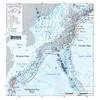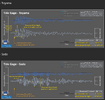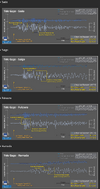some videos
The following may be a old video, but not sure.
Animal behavior
The following may be a old video, but not sure.
Animal behavior
Q: (T) You predicted a quake in Japan, near Osaka, several sessions back, you were off by the magnitude a little bit and by the miles a little bit, but basically you were correct. What between that prediction and the prediction for the Tokyo quake can Japan expect?
A: Not correct interpretation. Osaka quake yet to be.
Q: (T) So this was not the quake that you predicted the 8.9, this was a 7.2, but it was miles distance from Osaka almost right on the money, but this was not the quake that you predicted? (J) There's going to be another one coming?
A: Yes 14 more this sequence. (?? 14 more this sequence ??)
Q: (T) 14 more quakes? (J) I'm sorry, I'm losing it real bad tonight, I don't know why. {She was referring to her inability to keep up with the speed of delivery.} (D) Are you breaking up? (J) No, it's me. Please repeat the answer. (T) We're having problems down here in 3rd density this evening!
A: SEQUENCE.
Q: (T) This is one in a sequence of earthquakes that are going to culminate in the 8.9?
A: 9 pt 6
Q: (T) In Osaka, near Osaka?
A: Tokyo.
Q: Okay, that's the one you talked about, then a 9.6, that's going to be the culmination of the quakes in this. This is only the 3rd or 4th in a sequential series and the 8.9 that's going to hit them hasn't happened yet.
A: 7th.
Q: (T) This is the 7th earthquake?
A: Yes.
Q: (T) 7.2 was the 7th earthquake, there's going to be 14 of them, is that what you said before?
A: Yes.
Q: (J) So there's 7 more coming? (T) So the 14th one will be the big one, in Tokyo?
A: 13th.
Q: (T) Okay, the 13th is going to be the 9.6 and I think the other prediction was 9.8, they're close. That'll be the 13th. What will be the 8.9, which one of those will be the Osaka 8.9?
A: Within next 4.(in the sequence?)
Q: (T) What will the 14th be?
A: Small.
Q: (T) So they're going out anticlimactically on the last quake. Is Mt. Fujiyama going to explode, is the volcano going to become active again?
A: Maybe.
Q: (T) Will these quakes, is China, Korea, Philippines and the surrounding area also going to be affected as these quakes increase in strength?
A: Yes.
Q: (T) Are we talking about putting about 30% of the world's industrial output out of business in the next year and a half or so?
A: No.
Q: (T) They're not going to recover anytime soon, ok so when this all happens is there going to be an effect on California of all of this, on the West Coast of this country?
A: Yes.
Q: (T) Not just California. Is Los Angeles going to be hit with any of these big earthquakes as the plate on the other side moves?
A: Yes.
Q: (T) What magnitude?
A: 8.9
Q: (T) Where will that happen?
A: San Gabriel Mountains.
Q: (T) Is that outside of Los Angeles? San Andreas Fault line?
A: Yes.
Q: (T) Will this be very destructive to Los Angeles?
A: What do you think?
Q: (T) In the destruction of this area, is this going to increase the job potential on the East Coast, in order to then, this is really serious stuff here, because this is going to affect the economy the way it shifts...
A: Yes.
Q: (T) So it...
A: Mass exodus from California.
Q: (T) Those dumb people out there looked at that Osaka stuff and said, "Oh, you know, that might happen to us. OHHH, boy, the brain finally fired up out there. (J) They've been in denial about that out there... (D) Will that bring an influx of people to Florida?
A: Yes. 15 quakes.
Q: (D) And then they're going to move. (T) 15 quakes in the California area?
A: In near future.
Q: (T) Are we talking strictly the West Coast here?
A: California.
Q: (T) Are there going to be earthquakes elsewhere in the United States?
A: Yes.
Q: (T) 15 in the near future in California alone... (D) This is the beginning of the destruction of the state of California, there'll be separation from the North American continent. (T) Well, they said don't take that literally, or it will fall off, it's symbolic...
A: Open.
Q: (T) So look at it symbolically. (D) Okay. (J) Where are the other quakes going to be?
A: Hundreds.
Q: (T) Hundreds? Hundreds of earthquakes. Hundreds of places?
A: Yes.
Q: There's going to be that many additional earthquakes? Beside the 15 in California?
A: Yes.
Q: (T) We're going to be rocking and rolling on this continent! Of course, when you move a plate, that's a lot of stuff. Are we going to be seeing a lot of water damage on the coast?
A: Open.
Q: (T) Is the West Coast of Florida going to see a rising water level?
A: That is vague.
Q: (T) Is there going to be earthquakes in Florida?
A: Seismically stable.
Q: (T) Will the seismic activity cause the water level in Florida to go up?
A: No.
Q: (T) So, for the time being, during the quakes, we'll be fairly safe, but there's other things to worry about beside that?
A: Storms.
Q: (D) are we talking hurricanes?
A: Cyclonic.
Q: (J) Will there be any damage from such storms in this area?
A: Open.
Q: (C) Are these caused by nature? (T) Is all this activity being.. is natural?
A: Close.
I asked myself if these videos were from today or from 2011.I think it important to not jump the gun with sensational stuff that may not be the present reality. (old Fukushima vids) That said, the crow thing is interesting and it should be noted Fukuoka is far south of the quake. So maybe more to come.
I asked myself if these videos were from today or from 2011.

All the tsunami videos in the first post show the tsunami of March 2011.X should create a video comparison software and put when the video's are FIRST published. It was impossible to figure out which is the current one and which one is older one.
In fact, it looks like the 'inner side' of Japan, its western coast, has very rarely had a strong quake (in the modern era anyway).What stands out for me is the date, obviously, but also where it struck: a part of Japan which scientific authorities there estimated had a "0.1% - 3%" chance of experiencing a >6.0 quake "in the next 30 years."





